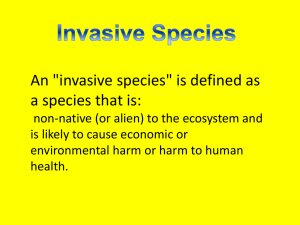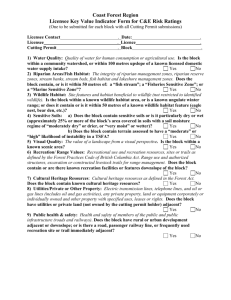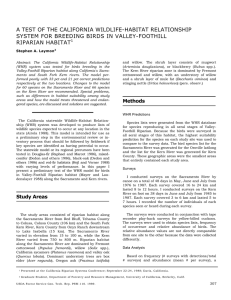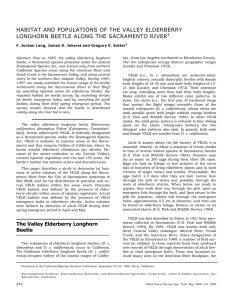DEVELOPING MANAGEMENT PLANS FOR CALIFORNIA RIPARIAN SYSTEMS Habitat Needs and Management
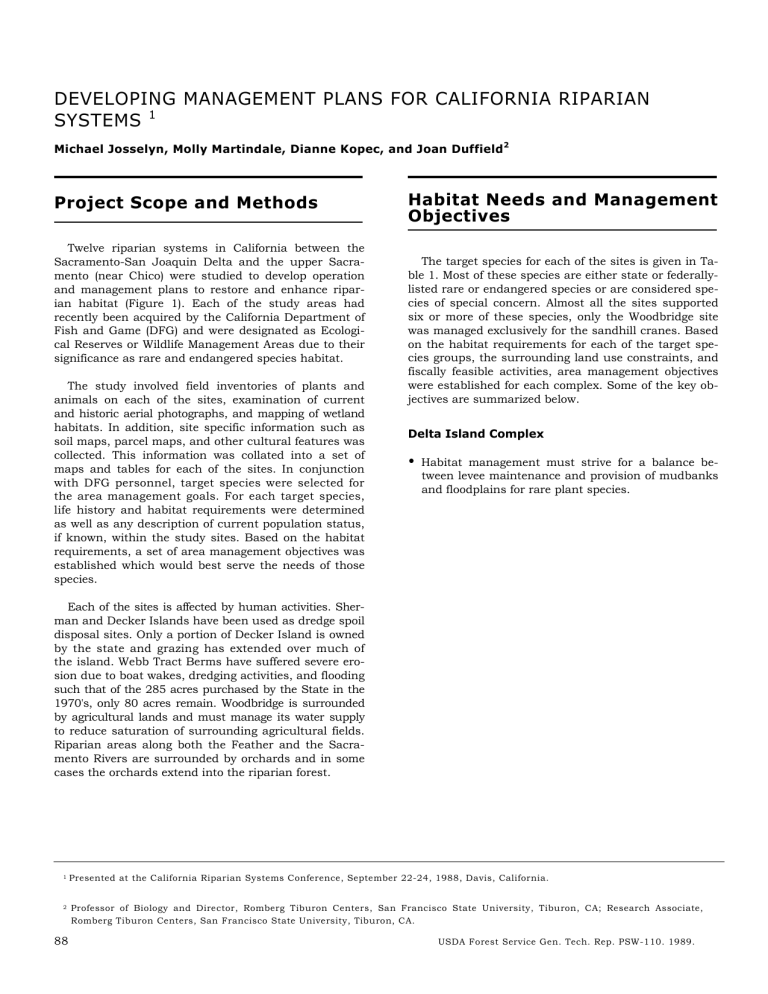
DEVELOPING MANAGEMENT PLANS FOR CALIFORNIA RIPARIAN
SYSTEMS
1
Michael Josselyn, Molly Martindale, Dianne Kopec, and Joan Duffield 2
Project Scope and Methods
Twelve riparian systems in California between the
Sacramento-San Joaquin Delta and the upper Sacramento (near Chico) were studied to develop operation and management plans to restore and enhance riparian habitat (Figure 1). Each of the study areas had recently been acquired by the California Department of
Fish and Game (DFG) and were designated as Ecological Reserves or Wildlife Management Areas due to their significance as rare and endangered species habitat.
The study involved field inventories of plants and animals on each of the sites, examination of current and historic aerial photographs, and mapping of wetland habitats. In addition, site specific information such as soil maps, parcel maps, and other cultural features was collected. This information was collated into a set of maps and tables for each of the sites. In conjunction with DFG personnel, target species were selected for the area management goals. For each target species, life history and habitat requirements were determined as well as any description of current population status, if known, within the study sites. Based on the habitat requirements, a set of area management objectives was established which would best serve the needs of those species.
Each of the sites is affected by human activities. Sherman and Decker Islands have been used as dredge spoil disposal sites. Only a portion of Decker Island is owned by the state and grazing has extended over much of the island. Webb Tract Berms have suffered severe erosion due to boat wakes, dredging activities, and flooding such that of the 285 acres purchased by the State in the
1970's, only 80 acres remain. Woodbridge is surrounded by agricultural lands and must manage its water supply to reduce saturation of surrounding agricultural fields.
Riparian areas along both the Feather and the Sacramento Rivers are surrounded by orchards and in some cases the orchards extend into the riparian forest.
Habitat Needs and Management
Objectives
The target species for each of the sites is given in Table 1. Most of these species are either state or federallylisted rare or endangered species or are considered species of special concern. Almost all the sites supported six or more of these species, only the Woodbridge site was managed exclusively for the sandhill cranes. Based on the habitat requirements for each of the target species groups, the surrounding land use constraints, and fiscally feasible activities, area management objectives were established for each complex. Some of the key objectives are summarized below.
Delta Island Complex
•
Habitat management must strive for a balance between levee maintenance and provision of mudbanks and floodplains for rare plant species.
1 Presented at the California Riparian Systems Conference, September 22-24, 1988, Davis, California.
2 Professor of Biology and Director, Romberg Tiburon Centers, San Francisco State University, Tiburon, CA; Research Associate,
Romberg Tiburon Centers, San Francisco State University, Tiburon, CA.
88 USDA Forest Service Gen. Tech. Rep. PSW-110. 1989.
Figure 1 —Location map for ecological reserves and wildlife areas.
USDA Forest Service Gen. Tech. Rep. PSW-110. 1989.
89
Woodbridge Ecological Reserve
• Expansion of shallow water with low vegetation to support roosting habitat for Sandhill Cranes.
• Provide extended open water habitat for waterfowl nesting .
Lower Feather River Complex
• Restore water levels within the backwater lakes.
• Restore mixed riparian forest within the floodway.
• Maintain tall snags and eliminate easements for firewood cutting.
Sacramento River Wildlife Areas
• Removal of nuisance species such as fig and salt cedar.
• Planting of valley oak and elderberry.
• Evaluate downstream impacts of streambank erosion control.
Costs
Total management and implementation costs for these project areas range between $250,000 and $600,000 over a 5 year period. These expenditures are necessary if these rare habitats are to serve for the diversity of wildlife now restricted by agricultural and urban development in the Central Valley.
Table 1. Target species for management goals for the
Sacramento River, Lower Feather River, Woodbridge and Delta
Islands Complexes.
COMPLEX PRIMARY SPECIES
Sacramento Valley Oak Forest
River Valley Elderberry
Longhorn Beetle
Yellow-billed Cuckoo
Swainson's Hawk
River Otter
Lower
Feather
River
California Hibiscus
Valley Elderberry
Longhorn Beetle
Giant Garter Snake
Yellow-billed Cuckoo
Swainson's Hawk
River Otter
SECONDARY SPECIES
California hibiscus
Bank Swallow
Yellow Warbler
Yellow-breasted Chat
Purple Martin
Long-eared owl
Ringtail
Turkey Vulture
Bank Swallow
Tricolored Blackbird
Heron Rookery
Ringtail
None
(Greater and Lesser)
California hibiscus
Delta Islands California Hibiscus
Mason's Lilaeopsis
Suisun Marsh Aster
Delta Smelt
Sacramento Splittail
California Black Rail
Salt marsh harvest mouse
Heron rookery
Black-shouldered kite
90
USDA Forest Service Gen. Tech. Rep. PSW-110. 1989.



